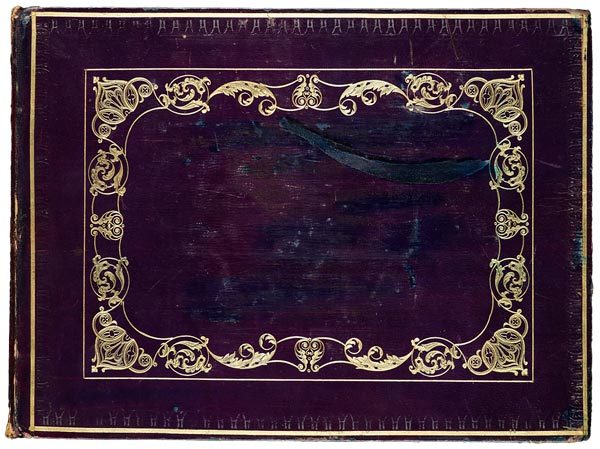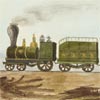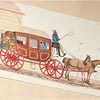 Niagara Honeymoon: Mary Ann and Septimus Palairet (1800s). A newly married couple from England traveled through America during the 1840s and recorded their impressions in words and pictures.
Niagara Honeymoon: Mary Ann and Septimus Palairet (1800s). A newly married couple from England traveled through America during the 1840s and recorded their impressions in words and pictures.
About the Diary
Mary Ann and Septimus Palairet of Bradford-on-Avon embarked on a honeymoon tour of the eastern United States and Canada in 1843. They created a travel diary together, with text by Mary Ann and drawings by Septimus, in a lovely album with a gold-tooled purple cover. "A fortnight might be spent in sketching, a book filled," Mary Ann wrote, "and yet there would be still subjects for the pencil left." Much like today's travel photographs or mobile updates, the Palairets' travelogue was probably not meant to be kept private—their highly polished account was no doubt shared with friends and family upon their return to England.
During a trip up the Hudson River on the steamboat Empire ("for such is the great Anti-Republican name," Mary Ann quipped) with a stop at West Point, the Palairets marveled at the young country's rapid development. In Rochester, Mary Ann observed a flourishing town "where some thirty years ago was a forest, peopled only by wild beasts or perchance a few Indians." Indeed, the Palairets bore witness to a period of unprecedented growth in transportation, communication, and invention in the United States. "During our travels we have seen the country in every stage of progress towards civilization," Mary Ann wrote, "from the natural forest to the cultivated fields or the busy town."
In their choice of a honeymoon destination, the Palairets were inspired by the example of their famous compatriot Charles Dickens, whose American Notes had appeared the year before. In fact, they passed on the opportunity to inspect a prison in Auburn, New York, "seeing that Mr. Dickens has described it for the benefit of all travelers." It was an era in which European comment on American culture abounded: Frances Trollope had published her Domestic Manners of the Americans in 1832, and Alexis de Tocqueville's celebrated Democracy in America—the most enduring of all nineteenth-century commentary on the young United States—was published in English in two volumes in 1835 and 1840.
 Like many travelers, the Palairets revealed their national prejudices. They were appalled at the hotels' meal schedule: "the American houses are so uncivilized—breakfast 7, dinner 1 or 2, and tea 5 or 6—and if any one is not ready to appear at the prescribed times, he stands a considerable chance of doing penance for his sin of idleness or forgetfulness." So when they reached Kingston, Ontario—a town with comfortable echoes of home—Mary Ann was delighted to find that dinner was "served up at 6!! There's a stride in civilization!"
Like many travelers, the Palairets revealed their national prejudices. They were appalled at the hotels' meal schedule: "the American houses are so uncivilized—breakfast 7, dinner 1 or 2, and tea 5 or 6—and if any one is not ready to appear at the prescribed times, he stands a considerable chance of doing penance for his sin of idleness or forgetfulness." So when they reached Kingston, Ontario—a town with comfortable echoes of home—Mary Ann was delighted to find that dinner was "served up at 6!! There's a stride in civilization!"
Even American children were found wanting. Mary Ann considered the Québécois youth "strikingly beautiful, especially to those who have been traveling in the 'States,' where infantine loveliness is scarcely to be seen." Despite the couple's strong sense of Canadian superiority, they were surprised to find French spoken there among the "lower orders." The French Canadians are "a very idle and dirty set, always lounging about in the market places," Mary Ann noted. "In fact Septimus became quite angry with them for not talking English, which they all can do."
But Mary Ann reserved her most scathing review for the French soprano Jeanne-Anaïs Castellan, who performed in the Thousand Islands during the Palairets' tour. "The American public have made such a fuss about the cantatrice and our Philadelphia friends pitied us so much for being unable to attend two concerts she gave there," Mary Ann wrote, "that we were unwilling to miss this opportunity of hearing her—especially as she is declared second only to Malibrau. Alas for Malibrau! I almost expected to see her ghost rise and like Banquo's 'push us from our stools' for sitting to listen to such a vulgar screamer."
Mary Ann considered herself a hardy traveler and noted with pride when a guide praised her English fortitude. She especially enjoyed walks around Niagara Falls, already a honeymoon destination by the early nineteenth century. Its glories surpassed her expectations a hundredfold: "To attempt a description of Niagara so as to give any idea of its sublimity is quite beyond the powers of the greatest writer that ever lived, and I shall certainly not be guilty of such an absurdity," Mary Ann admitted. "We gazed at the glorious sheet of falling waters, dashing down and losing itself in foam and spray which reflected back the sun's rays in the most brilliant rainbow ever seen, until we were suddenly reminded that we must hasten back to dinner. How very humiliating it is that such a thing as hunger will intrude itself even at Niagara!"
By the end of the honeymoon trip, Mary Ann and Septimus were likely expecting a child. Their son, Henry, was born in 1844, and Annie and Eleanor followed a few years later.
Cover of the diary of Mary Ann and Septimus Palairet, 1843. Gift of Arnold Whitridge, 1962
Self-portrait by Mary Ann Palairet, from the diary she kept with her husband, Septimus, 1843. Gift of Arnold Whitridge, 1962.


